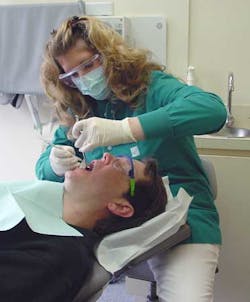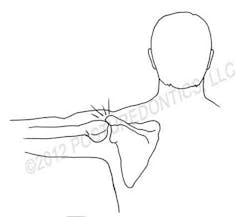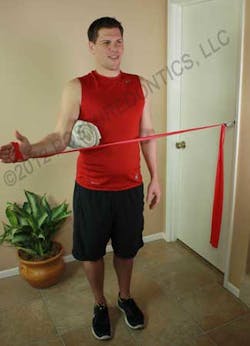Exercise of the Month for April 2013
VIDEO: External Shoulder Rotation
Rotator cuff impingement develops from gradual wearing of the tendon that passes between the humerus and acromion process. In hygiene, this is often due to frequently lifting the arms away from the sides (Fig. 1) or moving the arm improperly.Fig. 2: Impingement occurs when rotator cuff muscles become imbalanced.
Because hygienists are uniquely prone to this rotator cuff imbalance, they must be aware that certain generic shoulder exercises and gym machines (that aren’t a problem for the general public) can worsen this imbalance and put them on the fast track to impingement. It is important to regularly target specific muscles that stabilize the rotator cuff. An example of one such exercise is the External Shoulder Rotation exercise (Fig. 3).
Fig. 3: Endurance training of the shoulder external rotators is an important preventative exercise for hygienists.
Place a Theraband door anchor in a door that opens away from you at elbow height. Stand at a right angle to the door holding a small pillow or rolled towel between your elbow and your body. Squeeze your shoulder blades together then slowly rotate the arm outward. Keep the elbow pressed firmly against your side throughout the exercise. Repeat 10-20 repetitions on each side.
An alternate method is to grasp the elastic band at both ends with hands at hip width apart. Press elbows closely to your sides. Slowly rotate hands outward, and return. If the resistance is too high, unwrap the band once on one or both hands. Be careful not to let the arms "fly away" from the sides during this exercise. This is why a towel roll or similar object under the arm is a good idea.





